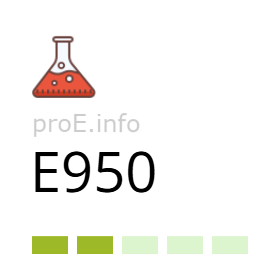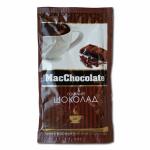
Other names for the additive (synonyms)
General Information
Food additive E950 (acesulfame potassium or acesulfame K) is a synthetic sweetener used in the food industry to provide a sweet taste without adding sugar.
Acesulfame K does not occur naturally; it is a fully synthetic compound. The substance was accidentally discovered by German chemist Karl Clauss in 1967. In 1983, the Joint FAO/WHO Expert Committee on Food Additives (JECFA) first approved acesulfame K for use in food products, and in 1998 the additive was authorised by the US FDA for use in soft drinks. Since then, E950 has been widely used in various food products across the world.
Similar to saccharin, acesulfame K has a slightly bitter aftertaste, especially at high concentrations. To mask this bitterness and enhance sweetness, E950 is often combined with other sweeteners, typically with aspartame or sucralose.
The chemical formula of acesulfame K is C4H4KNO4S. It is a white crystalline powder with a high level of sweetness. Acesulfame K is as sweet as aspartame, half as sweet as saccharin, one-fourth as sweet as sucralose, and approximately 200 times sweeter than regular table sugar. E950 is water-soluble, heat-stable, and resistant to hydrolysis, though it can degrade under pH levels below 3 and high temperatures, producing breakdown products such as acetoacetamide and acetoacetamide-N-sulfonic acid.
In the food industry, acesulfame K is produced synthetically through several chemical steps, followed by multistage purification including crystallisation, filtration, and recrystallisation. According to EU specifications, its purity ranges from 99.6% to 100.2%.
Effects on the Body
Risks of additive E950
After ingestion, acesulfame K is almost completely absorbed in the gastrointestinal tract, not metabolised, and excreted through the urine. E950 can cross the placenta and is excreted in breast milk, though exposure to breastfed infants is minimal.
The safety of acesulfame K has been studied for several decades. In 1985, the Scientific Committee on Food (SCF) established an Acceptable Daily Intake (ADI) of 9 mg/kg body weight per day. In 2023, the European Food Safety Authority (EFSA) re-evaluated acesulfame K and increased the ADI to 15 mg/kg body weight per day, finding no evidence of carcinogenicity or genotoxicity.
Breakdown products of acesulfame K, such as acetoacetamide, have been assessed as low-toxicity substances. However, for the impurity 5-chloro-acesulfame, EFSA recommended limiting its concentration to 0.1 mg/kg due to in silico genotoxicity alerts.
Long-term toxicological studies on rats and dogs did not reveal adverse effects even at high doses (up to 1.5 g/kg in rats). In its report, EFSA noted that studies in both animals and humans showed no association between acesulfame K intake and risks of cancer, cardiovascular diseases, or disturbances in glucose metabolism.
Benefits of additive E950
Acesulfame K is not a nutrient and provides no direct biological benefit to the human body. However, it contributes to reducing sugar intake, which can support weight management and help in the prevention of dental caries. E950 does not affect blood glucose levels, making it acceptable for use by people with diabetes.
Uses
Acesulfame K (additive E950) is used as a sweetener in a wide variety of products: soft drinks, juices, chewing gum, desserts, confectionery, baked goods, sauces, and dairy products. Thanks to its high heat stability, it is widely used in products that undergo heat treatment.
Acesulfame K is also utilised in the pharmaceutical industry to improve the taste of medications.
Legal Status
As food additive E950, acesulfame K is authorised for use in the food industry in the European Union under Regulation (EC) No 1333/2008. It is also included in the list of approved additives in the United States (FDA), Canada, Japan, Australia, and Ukraine.
